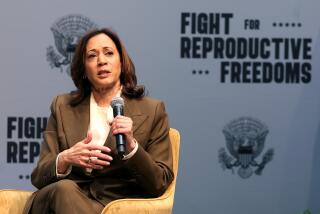Orange County Voices : COMMENTARY ON HEALTH CARE : By Dying On His Own Terms, Nixon Leaves Another Legacy : The former President’s refusal of artificial life support points to primacy of the individual decision.
In death as in life, we can learn from former President Richard M. Nixon. His refusing artificial life support has fueled the debate over medical care for the terminally ill.
Nixon’s advance directive was a deeply personal, appropriately selfish act, an acknowledgment that, at a time when critical medical decisions must be made, our loved ones may be emotionally overwhelmed and unable to provide appropriate guidance to the physician.
Physicians, too, may have difficulty “letting go” of a patient they have cared for for many years.
Modern medicine has created public expectations of positive outcomes--only positive outcomes. Repeated polling shows broad public support for physician-assisted dying (suicide raises other issues not covered here).
Yet, despite a federal law requiring patients be informed of their right to refuse end-of-life treatments, few exercise this crucial basic right to make their own final decisions by signing a simple document, the Durable Power of Attorney for Health Care. The form was developed by the California Medical Assn. and can be filled out by anyone.
Making such determinations is the most private of decisions and underscores the essence of the physician-patient relationship. It becomes the bridge between life and death when the patient is unable to express his or her own desires.
Patients and physicians must reach a consensus soon and define reasonable and flexible guidelines for the care of those who have not already expressed their wishes.
If we do not, those riding the crest of the health care cost-containment wave may make the decision for us.
From my perspective, I was trained to cure, not retreat from attacking illnesses such as cancer, AIDS, heart disease, Alzheimer’s and sudden violence. It can literally be a fight to the death and my reflex is to attack disease aggressively unless it is clear my patient wants otherwise.
As a physician, it is very difficult to not do what I was trained to do. Also, many patients with a strong desire to live survive far beyond the medical norm. But in my training, I learned the foremost dictum of medicine--primum non nocere--first, do no harm.
As a general internist with many older patients and as a hospice medical director, I have dealt extensively with these issues.
Despite clear patient directives to their family and to me, I have revisited the entire process with aggrieved spouses or children still unwilling to let their loved one go, acting as referee in a very emotional family debate.
In cases where no directive was given, how far can a physician go in advocating for the silent patient who previously confided their wishes to their physician?
In practice, most Americans support “ending life” when artificial life support will only delay death--but not with their loved one. Physicians and families should ask “are we providing these treatments for the patient or for ourselves?”
Nixon’s dying should compel us all to make our choices before the grief and trauma of our condition puts our families and physicians in doubt, or worse, in conflict. After all, choosing how we want to die is exercising the same responsibility we take in daily living.
There are other parts of this decision-making process, including psychological and spiritual care and unfortunately, fear of hindsight. Physicians and health-care facilities still fear lawsuits by family members opposing the patient’s expressed wishes.
Patients, physicians and other impacted providers must join this debate in earnest. The advance directive is perhaps the most personal and individual of decisions. Family concerns matter, but the individual should make the call.
Fortunately, the focus has already begun shifting toward palliative care, the relief of pain and suffering. The end-of-life debate also has raised government’s consciousness, with the issuance of new federal pain management guidelines. The health care marketplace is evolving, supporting more appropriate vehicles for end-of-life care.
For example, hospice care gives the terminally ill their right of self-determination and is a cost-effective alternative for such care. Almost all patients prefer to spend their final days at home, rather than in a hospital.
The pejorative term “futile care” may suggest health care rationing but what it really means is care that does not work. The development of scientifically valid, uniform standards and protocols would help us all.
Patients and their families could, with the aid of their physicians, make rational decisions regarding care at the end of life. The serious ethical and moral issues that arise when advances in medical technology conflict with a patient’s stated desire to refuse such care could be addressed in a more rational context. A bill to help address this issue is currently pending in our state Legislature.
Until we come to a consensus on end-of-life treatment and care, we should promote the primacy of the individual decision made by President Nixon and involve the public in this debate.
If we address these issues now, the next generation of Americans and their physicians will be better able to come to terms with saying farewell to our loved ones.
More to Read
Sign up for Essential California
The most important California stories and recommendations in your inbox every morning.
You may occasionally receive promotional content from the Los Angeles Times.










